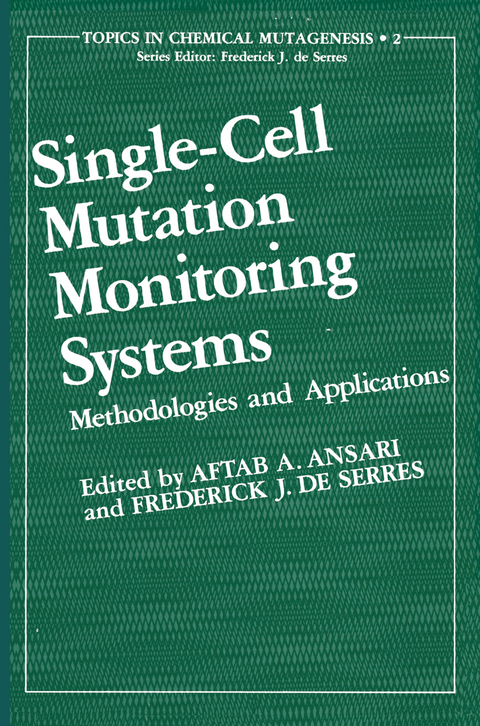
Single-Cell Mutation Monitoring Systems
Springer-Verlag New York Inc.
978-1-4684-4666-1 (ISBN)
1. Somatic-Cell Mutation Monitoring System Based on Human Hemoglobin Mutants.- 1. Introduction.- 2. The Hemoglobin Mutants.- 3. Hemoglobin in Mutation Research: Gametal Mutation Rates.- 4. A System for Detecting Somatic Mutations of Hemoglobin.- 5. Methodological Aspects: Monospecific Anti-Mutant-Hemoglobin Antibodies.- 6. Methodological Aspects: Monoclonal Anti-Globin-Chain Antibodies.- References.- 2. Use of Fluorescence-Activated Cell Sorter for Screening Mutant Cells.- 1. Introduction.- 2. Immunologic Identification and Flow Detection of Erythrocytes Containing Amino Acid-Substituted Hemoglobin.- 3. Future of the Hemoglobin-Based Assay.- 4. Detection of Erythrocytes with Mutationally Altered Glycophorin A.- 5. Summary and Conclusions.- References.- 3. Development of a Plaque Assay for the Detection of Red Blood Cells Carrying Abnormal or Mutant Hemoglobins.- 1. Introduction.- 2. Principle of the Method.- 3. Reagents.- 4. Equipment.- 5. Procedure for the RBC-Antibody Plaque Assay.- 6. RBC-Protein A Plaque Assay.- 7. Conclusions.- References.- 4. Direct Assay by Autoradiography for 6-Thioguanine-Resistant Lymphocytes in Human Peripheral Blood.- 1. Introduction.- 2. Autoradiographic TGr T-PBL Assay Method.- 3. Sample Results.- 4. Statistical Analysis Methods.- 5. Discussion.- References.- 5. Application of Antibodies to 5-Bromodeoxyuridine for the Detection of Cells of Rare Genotype.- 1. Introduction.- 2. Materials and Methods.- 3. Results.- 4. Discussion.- 5. Summary.- References.- 6. Cytogenetic Abnormalities as an Indicator of Mutagenic Exposure.- 1. Introduction.- 2. Lymphocyte Assay Methodology.- 3. Chromosome Aberration Analysis Following Radiation or Chemical Exposure.- 4. The Analysis of Bone Marrow Samples.- 5. The Plausibility of Estimating Genetic or Carcinogenic Risk from Aberration Frequencies in Lymphocytes.- 6. Concluding Remarks.- References.- 7. Sister Chromatid Exchange Analysis in Lymphocytes.- 1. Introduction.- 2. Methodology.- 3. Selected Applications.- Appendix A. A Procedure for Growing and Preparing Human Lymphocytes for SCE Analysis.- Appendix B. A Procedure for Growing and Preparing Rat Lymphocytes for SCE Analysis.- References.- 8. Unscheduled DNA Synthesis as an Indication of Genotoxic Exposure.- 1. Introduction.- 2. Four Laboratory Approaches to Measuring Unscheduled DNA Synthesis.- 3. Methods.- 4. Reagents, Solutions, Stains, and Media.- 5. Equipment and Supplies.- References.- 9. The Micronucleus Test as an Indicator of Mutagenic Exposure.- 1. Historical Background.- 2. Rationale of the Test System.- 3. Technical Procedure.- 4. Results and Comparative Studies.- 5. Related Assay Systems.- 6. Advantages.- 7. Limitations.- 8. Application of the Micronucelus Test.- References.- 10. The Identification of Somatic Mutations in Immunoglobulin Expression and Structure.- 1. Introduction.- 2. Immunoglobulin Protein and Gene Structure.- 3. Methods for the Isolation of Mutants.- 4. Frequency and Phenotypes of Mutants.- 5. Discussion.- References.- 11. Detection of Chemically Induced Y-Chromosomal Nondisjunction in Human Spermatozoa.- 1. Introduction.- 2. Background.- 3. Agents That Increase YFF Bodies in Human Sperm.- 4. Discussion.- References.
| Reihe/Serie | Topics in Chemical Mutagenesis |
|---|---|
| Zusatzinfo | XVIII, 290 p. |
| Verlagsort | New York, NY |
| Sprache | englisch |
| Maße | 152 x 229 mm |
| Themenwelt | Sachbuch/Ratgeber ► Natur / Technik ► Garten |
| Veterinärmedizin | |
| ISBN-10 | 1-4684-4666-5 / 1468446665 |
| ISBN-13 | 978-1-4684-4666-1 / 9781468446661 |
| Zustand | Neuware |
| Haben Sie eine Frage zum Produkt? |
aus dem Bereich


